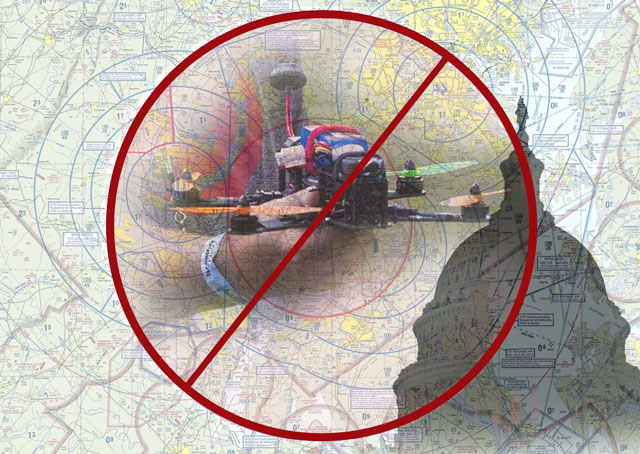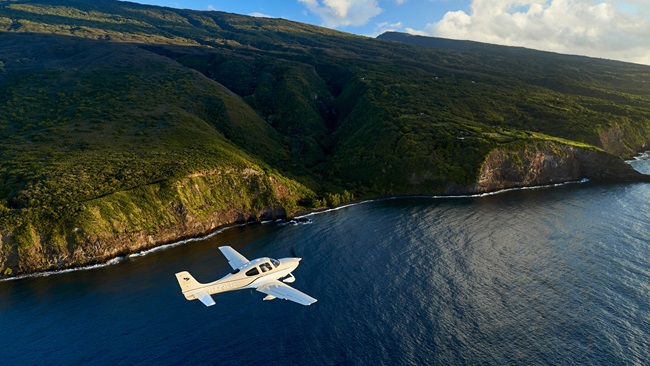
The nation’s second highest court now has two cases before it challenging recent actions taken by the FAA to regulate aircraft weighing less than 55 pounds and flown by hobbyists.
The legal tug of war between the FAA and enthusiasts (including the world’s largest model aircraft hobbyist organization) may be decided about 30 miles from the nearest place a hobbyist can legally fly a small unmanned aircraft, as of Sept. 2. That’s when the FAA expanded the Washington, D.C., no-drone zone far beyond its original size, which was bounded by the Flight Restricted Zone, extending up to 15 nautical miles from Ronald Reagan Washington National Airport.
The FAA notified the Academy of Model Aeronautics hours before updating a 1981 advisory circular on model aircraft rules to include new language that made the Washington, D.C., Special Flight Rules Area—covering everything within a 30-nm radius of the DCA VOR—a no-fly zone for model aircraft, or unmanned aircraft, terms that are defined inconsistently in various laws and regulations.
As a result, 14 AMA clubs were grounded in an instant by a single advisory circular, and the FAA added more than 2,000 square miles of Virginia and Maryland to the no-fly zone for drones, more than tripling its size.
AMA advised its members in December to comply with the September directive, noting that litigation was already underway, and that the organization was also negotiating with the FAA to resolve this particular impasse.
Caught by surprise
Being lumped in with those who fly quadcopters thousands of feet in the air near busy airports, fit them with guns, or crash them into crowds, came as a surprise to AMA members including Scott Strimple. The 44-year model aircraft enthusiast is also a captain for a major airline with more than 25,000 flight hours, and an authorized commercial operator of many of the larger camera-toting drone models used by civilians. Strimple is often called on by media organizations and others seeking education in the safe operation of small unmanned aircraft systems.
He is also out of luck if he wants to fly a radio-controlled aircraft within 30 miles of Ronald Reagan Washington National Airport. Strimple, in a telephone interview, said he and fellow model aircraft enthusiasts “are just sitting here with our mouths hanging open, saying, 'What’s this all about?'”
Hobbyists had, until June 2014, assumed that Congress had them covered, having directed the FAA in 2012 to keep its regulatory hands off hobbyists. There was, however, one exclusion within the 2012 law to that “hands off” directive, a caveat that the FAA seized upon amid growing alarm over reckless drone operators.
“Nothing in this section shall be construed to limit the authority of the Administrator to pursue enforcement action against persons operating model aircraft who endanger the safety of the national airspace system.”
That sentence, vague as it may be, is shaping up to be one of the key points of debate in a legal and regulatory battle that could spill over into the manned aircraft world, in the view of Jonathan Rupprecht, a Florida attorney who has built a busy practice around unmanned aircraft. An outspoken critic of FAA drone policy, Rupprecht has authored books and blogs on the subject, and he is also a certificated flight instructor and graduate of Embry-Riddle Aeronautical University.
“I think pilots need to realize that the drone community is kind of like their crazy black sheep rebellious brother,” Rupprecht told AOPA. He likened the drone world to the “canary in the coal mine” and the “first to feel FAA overreach.”
Rupprecht, who is not representing parties in the cases now being litigated in a federal courtroom (though he noted he’s doing the research, and is available), said that if the FAA is allowed to circumvent the rulemaking process and force hobbyists to register drones (and traditional model aircraft whose operators long-believed they were exempt from FAA regulation), “what happens when the FAA starts changing it around and starts going after manned aircraft pilots?”
Flying into the Washington, D.C., Special Flight Rules Area, he noted, could get more difficult for every pilot.
“It’s not manned versus unmanned. (We) really should phrase it as, everybody should follow the law,” Rupprecht said. “The FAA did not follow the law. They’re kind of making up law, and pushing it off on one group.”
Drones behaving badly
An outsider to that particular group by virtue of claiming foreign residence posted a YouTube video in March 2014 that has been viewed more than 3.3 million times, likely populating the nightmares of many pilots. It depicts a six-rotor, off-the-shelf copter ascending through clouds to more than 3,300 feet and hovering there for a while, before things head south. The drone refuses to budge when commanded to descend, and the panicked and distracted operator allows it to drift hundreds of feet off course. The wayward craft was still high in the air when it ran out of battery power and crashed into a tree, narrowly missing homes. The video post includes a lengthy mea culpa, commentary on lessons learned, and pledges to never do it again (and to delete YouTube comments that reiterate the various violations of common sense that the 11-minute film documents). The poster even offers advice to fellow droners: “Never ever take any unnecessary risks. It is never worth it. I got away with it this time, but I could as well have ended up hurting or even killing someone on the ground."
Irresponsible drone use became a worldwide phenomenon as advancing technology produced cheap systems capable of flying thousands of feet in the air while feeding live video back to the ground, and the FAA started collecting reports in 2014 from pilots, bystanders, law enforcement agents, and others. Some described similar behavior.
The same month as the ill-fated attempt at drone VFR-on-top video posted on YouTube, the FAA suffered a setback in its nascent effort to bring rogue drones to heel. Drone pilot Raphael “Trappy” Pirker persuaded an administrative law judge that the FAA had no authority to fine him $10,000 for filming with a drone for profit in 2011. The FAA appealed that ruling to the NTSB, defending its right to fine Pirker, the lead pilot of Team BlackSheep, a high-profile company in the drone world known for making movies and more recently for retail and services. Pirker wound up settling the case and paying a $1,100 fine without admitting guilt or any violation. Thus ended the FAA’s first attempt to enforce an agency policy dating to 2007 that prohibited commercial use of small unmanned aircraft.
Years later, only a couple of dozen enforcement actions related to drone use have been brought by the FAA; federal officials cited the difficulty in tracking down misbehaving operators when implementing in December a new rule requiring registration of small unmanned aircraft flown by hobbyists. That requirement was quickly challenged, though not by the AMA, which already had a pending petition in federal court.
Challenges mount
Within 10 days of the new registration requirement's unveiling, John Taylor, a Maryland attorney and drone enthusiast filed his own petition with the District of Columbia Court of Appeals challenging the registration requirement in much the same way the AMA had challenged the FAA’s right to regulate model aircraft in its own petition filed in August 2014. The AMA petition has been put into a legal holding pattern while the FAA decides whether and how it will enforce rules written for manned aircraft with respect to model aircraft and drone operators. The FAA is sorting through 33,000 comments received on its 2014 notice that it would treat all aircraft the same, regardless of size.
Meanwhile, the number of reported drone sightings by pilots and others skyrocketed in 2015 though critics (including AMA) contend the sighting reports released by the FAA overstate the danger actually posed by drone operators.
The FAA, and those petitioning the nation’s second highest court to squash any rules aimed at small aircraft hobbyists, all cite the language of Section 336 of the 2012 FAA Modernization and Reform Act, which states in part that that the administrator “may not promulgate any rule or regulation regarding a model aircraft, or an aircraft being developed as a model aircraft” by hobbyists. The FAA has taken the position that this language does not limit its ability to apply regulations written for manned aircraft in past years to model aircraft flown by hobbyists today, and much will depend on how the appellate judges define the word “promulgate.” (Not to mention, “model aircraft.”)
The court has ordered parties in the Taylor case to file various documents by Jan. 27. AMA has meanwhile advised its members to hold off on registering their model aircraft.
“AMA and the AMA District IV Government Relations Committee are currently in talks with the FAA to find a solution that will allow our members to resume the enjoyment of their long-standing hobby in the impacted Virginia and Maryland counties,” said Richard Hanson, AMA's government and regulatory affairs representative, in a statement provided to AOPA. “More broadly, AMA has been working closely with the FAA and the Association for Unmanned Vehicle Systems International (AUVSI) on the Know Before You Fly campaign to educate newcomers to model aviation and drone technology. Education, not more regulation, is the key to enhancing safety.”
FAA Administrator Michael Huerta announced at the Consumer Electronics Show in Las Vegas Jan. 6 that the agency’s B4UFLY app, in beta testing since May, has been released for devices running Apple and Google software. (Following the Google link Jan. 7 led to an invitation to “become a tester.”)
“It is another important part of our education and awareness efforts to foster a culture of safety and accountability for the UAS community,” Huerta said.



